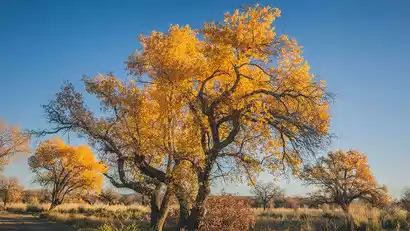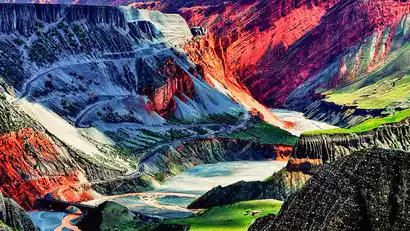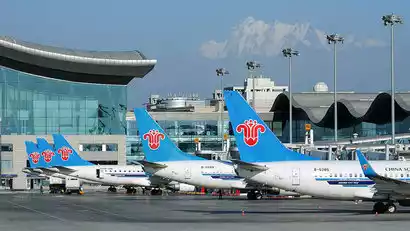Day 1 Various locations - Urumqi (★Activity gathering day)
All day
Today is the gathering day for the event. All tourists will proceed to the meeting hotel in Urumqi, the capital of Xinjiang Autonomous Region. Simply provide "China-Travel Note + Name" to check in.
Located in the heart of Asia, Urumqi is world-renowned for its song and dance, fruits, gold, and jade. If you have more time, you can plan your own activities in downtown Urumqi. For those interested in learning about Xinjiang's culture and history, the Xinjiang Museum (closed on Mondays) is a top choice. For an exotic experience, the International Grand Bazaar showcases unique Western culture and a dazzling array of goods—you might find some great finds.
When in Urumqi, don't miss Xinjiang delicacies: the nationally renowned Dapanji (Big Plate Chicken), crispy grilled lamb chops, grilled lamb skewers, Yili horse intestines, and various noodles. Urumqi remains bustling at night, so stroll and eat at the Grand Bazaar Night Market.
Kind tips:
Urumqi Airport is relatively close to the meeting hotel in the city center. A taxi from the airport to the meeting hotel costs about 30-45 yuan.
Border Pass Description: (Updated on July 23)
China-TravelNote will handle border control passes on D4, one per person (bring your ID card and handle it yourself).
Children under the age of 16 must be accompanied by their parents (bring the original or copy of their household registration booklet); non-guardians must bring a letter of authorization.


Day 2 Urumqi → Junggar Basin → No. 3 Mine → Keketuohai Town
·morning
Today we're crossing the Junggar Basin, known as China's second-largest basin, from the foot of the Tianshan Mountains to the Altai Mountains in the far northwest. The journey is long and arduous, but the team leader breaks the ice, and everyone quickly becomes familiar with each other.
We will fully experience the vastness of Xinjiang, passing the edge of the Gurbantunggut Desert (which is also the second largest desert in China), through the Karamay Ungulate Reserve, and the vast Gobi Desert along the way.
·afternoon
We'll have lunch in a small town along the way, then continue north to Altay. If you're lucky, you might encounter the stunning autumn migration of Kazakh herders. During the autumn season, nomadic Kazakh herders, carrying their cattle, sheep, camels, and horses, along with their belongings, migrate from their summer pastures in the mountains to their winter pastures in the lower terrain. The overwhelming herds of cattle, sheep, and horses, stirring up clouds of dust, create a magnificent spectacle. (The migration of Kazakh herders is quite random, so you can't guarantee you'll see them every tour period.)
Afterwards, we'll visit the Keketuohai Mine No. 3, where records indicate 86 of the world's 140-plus known minerals, including some extremely valuable rare metals. This mine not only helped China repay part of its foreign debt to the former Soviet Union but also provided key rare metal raw materials for the successful development of China's atomic and hydrogen bombs and artificial satellites, earning it the nickname "The Meritorious Mine."
China-TravelNote specially arranged for participants to put on miners’ hats and go deep into the Ayiguozi mine. Together with professional tour guides, they could listen to stories of past struggles, learn about various rare metals, and uncover the great significance of the No. 3 mine.
After the tour, check in to the hotel and rest. In the evening, you can invite your friends to taste the local specialties freely!


Day 3 Keketuohai National Geopark → Wucai Beach (Sunset) → Burqin
·morning
After breakfast, we'll depart for Keketuohai National Geopark, also known as the Irtysh River Grand Canyon. This is the source of the Irtysh River, the only river in China that flows into the Arctic Ocean. We'll take a scenic bus along the valley, admiring the autumn beauty of birch forests, stone gates, and couple trees. We'll also visit and photograph the iconic "Shenzhong Mountain," the landmark of Keketuohai. Afterwards, we'll hike deeper into the Irtysh River Gorge (you can also take an electric car at your own expense) and admire the vibrant autumn colors etched across the canyon's massive rock faces. Keketuohai's vibrant autumn colors, with its vibrant forests, will leave you wanting more.
·afternoon
Leaving Keketuohai, we travel west along the Irtysh River to arrive at the "Waterside Yadan" [Wucaitan]. The rocks along the Irtysh River are rich in minerals, which transform into various colorful colors in the sunset, hence the name "Wucaitan".
Arrive at the Russian-style town [Burqin] hotel in the evening and check in. You can go to the riverside night market to taste local specialties at night.


Day 4 Burqin → Hujirt Transit Road → China-Kazakhstan Border Highway → Baihaba
·morning
We journeyed westward, heading into the vibrant heart of the Altai Mountains. En route, we obtained a Baihaba Border Pass (required ID), then journeyed to Baihaba, the "First Village in Northwest China" on the China-Kazakhstan border. The deeper we drove, the more vibrant the autumn colors became. (China-TravelNote specifically arranged to take the western route from Tierekti to Baihaba, offering breathtaking views of the autumn scenery along the China-Kazakhstan border highway. The scenery was sparsely populated and breathtaking, and we didn't want to turn back.)
On the way, we'll pass the Hujierte Migration Road, a large herdsman in the Kanas region. Every autumn, herders migrate their cattle and sheep from high-altitude pastures to lower ones. With luck, you might spot a large herd of herders passing through, and China-TravelNote will allow time for you to admire and photograph this scene. (Note: The migration schedule varies from year to year, lasting approximately 2-3 weeks. Weather and other factors may affect this, so not every group can be photographed. Please understand this).
·afternoon
Afterwards, transfer to a scenic bus and travel along the China-Kazakhstan border highway to Baihaba Village, a quiet mountain village in the northwest of China, across the river from Kazakhstan. The villagers are a mix of Tuvans and Kazakhs. All the buildings in the village are made of wood, and the log cabins blend harmoniously with the surrounding environment, creating a sense of paradise.
After arranging your accommodation, you'll be free to explore the surroundings and experience the life of a herder, living in isolation. Take a scenic bus to Yegende Sky Grassland (free) to admire the lonely tree. At sunset, climb the hillside next to the village to admire the sunset glow. At night, the sky over Baihaba is filled with stars, and the Milky Way looks like a silvery galaxy.


Day 5 Baihaba → Kanas (Fish Watching Terrace, Kanas Lake, Sanwan Light Hiking) → Jiadengyu
·morning
Tourists who love photography get up early and go to the Baihaba Viewing Platform at the entrance of the village to take pictures of Baihaba in the morning light. The morning mist drifts in the valley and the smoke rises, which is like a dream.
After breakfast, depart Baihaba by shuttle bus and travel along the scenic highway to Kanas, the "Backyard of God." Autumn here is like a palette of colors, with leaves gradually turning red, bright yellow, brown, and green. Against the backdrop of blue skies, white clouds, and towering snow-capped mountains, the scene resembles a fairyland on earth.
Arrive at the Kanas Transfer Center and transfer to a scenic bus for the journey to Kanas Lake. Along the lakeside plank road, admire the golden autumn colors on both sides. If conditions permit, we'll ascend to the Fish Viewing Platform at an altitude of 2,030 meters. With a vertical drop of over 600 meters above the lake, this is the vantage point for panoramic views of Kanas Lake.
·afternoon
Enjoy a light lunch at noon within the scenic area. In the afternoon, head to the famous Three Bays of Kanas (Shenxian Bay, Moon Bay, and Wolong Bay), where you'll get up close and personal with the Kanas River and photograph the reflections of the boundless autumn colors. China-TravelNote will lead you on a hike through the highlights of the Three Bays (the Moon Bay to Wolong Bay section, approximately 3 kilometers long, primarily downhill, and relatively easy), along the riverside wooden plank path, enjoying the stunning autumn scenery of Kanas.
Of course, tourists who don't want to hike can opt for scenic bus stops along the way. Meet at Wolong Bay, take the shuttle bus, and stay overnight in Jiadengyu Town, the gateway to Kanas Scenic Area. (Our bus will meet you at Jiadengyu, so you can check in your luggage there.)


Day 6: Jiadengyu → Hemu (full day tour, strolling in the birch forest/hiking to Meili Peak)
All day
After breakfast, we depart for Hemu, known as "God's Private Reserve." We'll transfer to the scenic bus and enter Hemu Village. The Hemu Highway offers stunning autumn scenery (no parking is allowed along the way, so enjoy the scenery and photography from the car). We'll then check in and have some free time at our leisure.
Suggestions for free activities in Hemu Village:
1. Choose to hike or ride horseback to the rarely visited [Meilifeng Grassland] (about 5 kilometers one way, 10 kilometers round trip, mainly flat roads; if riding a horse, please pay attention to safety and pay the fee at your own expense); Meilifeng, surrounded by mountains, is colorful.
Tourists who prefer not to hike can stroll along the jade-like banks of the Hemu River, through the golden birch forests, occasionally encountering herders herding their flocks. The sunlight filtering through the trees creates a fairytale-like experience. Alternatively, wander through Hemu Tuwa Village, basking in the sun in the courtyard, sipping tea, reading, and simply daydreaming.
In the evening, head to the Hemu Sunset Observation Deck for a panoramic view of Hemu Village. Admire the Tuva villages, where smoke curls from cooking fires under the setting sun, the brisk flow of the Hemu River, and the return of cattle and sheep. Return to the inn after sunset. Tourists who enjoy stargazing shouldn't miss this opportunity; on clear days, gaze up at a sky filled with stars.


Day 7 Hemu → Wuerhe Ghost City → Wuerhe
·morning
Don't sleep in when you're in Hemu! Hike to the Harden Observation Deck to admire the famous "Hemu Sunrise and Morning Mist." The morning light casts a shadow over the golden birch and Siberian pine forests, while the mist drifts through the valley and smoke rises from cooking fires. The scene is breathtaking and breathtaking.
·afternoon
We'll then visit the Urho Ghost City, one of China's three most beautiful yardangs, selected by National Geographic. Millions of years of wind erosion have shaped this bizarre, almost magical landscape, with occasional gusts of sand threatening to swallow you. After enjoying our visit, we'll return to our hotel for the night.


Day 8 Wuerhe → Secret Populus euphratica Forest → Anjihai Grand Canyon → Urumqi
·morning
After breakfast, we'll set out to explore the Wuerhe Secret Populus euphratica Forest, renowned for its immortality, enduring for a thousand years, and immortality even after death. Privately discovered by the China-TravelNote team, this vast expanse of wild Populus euphratica stands tall and dense, each one boasting a remarkably unruly presence.
·afternoon
Afterwards, we'll visit the Anjihai Grand Canyon (also known as the Red Mountain Grand Canyon). Reopened after a four-year hiatus, the Tianshan Mountains, eroded by glacial meltwater, have carved a rift valley over 100 meters deep. The exposed rocks, reddish-brown karst landforms, terraced grasslands, and braided river channels create a breathtaking natural landscape. After your enjoyable visit, return to your hotel in Urumqi to rest.
Important Note:
1. The Anjihai Grand Canyon has a relatively pristine landscape. If it is closed due to bad weather, you can visit the Dushanzi Grand Canyon instead. Tickets will be covered by China-TravelNote. Please understand.
2. We will return to Urumqi later today (estimated to be around 8 PM). We have included hotel accommodation for tonight and do not recommend flights departing that night.


Day 9 Urumqi (★All day)
All day
On the day of disbanding, the tourists reluctantly left the beautiful Xinjiang and returned to their respective warm homes according to their flight or train schedules.
Kind tips:
Urumqi Airport is close to the hotel in the city center. A taxi ride costs about 30-45 yuan and takes 20-30 minutes. It is very convenient.







